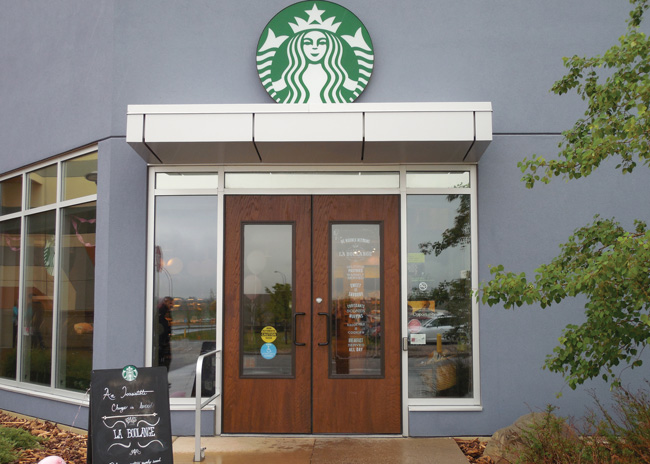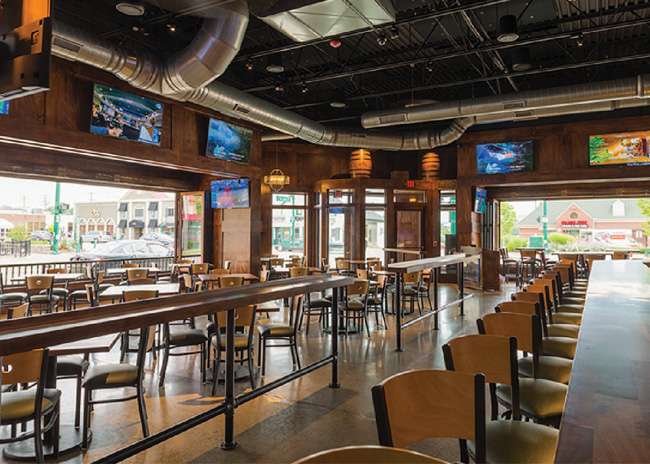 Ask five different designers to tell you their favorite restaurant design, and you’ll most likely get five widely varying answers. To one designer, it may be an ultra-modern concept that’s all about the stylishness of the front-of-house area. To another, it could mean a well-designed kitchen that moves high volumes of food out of the kitchen efficiently. To yet a third designer, it could mean taking an established concept and giving it a more up-to-date look.
Ask five different designers to tell you their favorite restaurant design, and you’ll most likely get five widely varying answers. To one designer, it may be an ultra-modern concept that’s all about the stylishness of the front-of-house area. To another, it could mean a well-designed kitchen that moves high volumes of food out of the kitchen efficiently. To yet a third designer, it could mean taking an established concept and giving it a more up-to-date look.
For most people in the restaurant industry, whether designers, owners or management, a favorite design is made up of a combination of elements because every part of a successful restaurant interacts with every other part. Stylish design in the front of house isn’t enough to compensate for inefficiencies in the kitchen. Conversely, a kitchen that works efficiently won’t bring in the customers if the seating and ordering areas aren’t attractive and functional.
Unlike many other businesses, even a seemingly minor change made in a restaurant can have an effect on everything else in the operation. For example, new floor coverings can have an effect on the noise level. Adding a piece of equipment can drastically affect the flow of workers in the kitchen area. So, a really effective restaurant design can be thought of as a combination of elements that all work in harmony to enhance the customer experience.
The stories on the following pages will show you some ways to make any restaurant design more eye-catching and efficient.
Restaurants with an open kitchen design are more popular than ever. The ability to see food being prepared adds visual appeal and excitement to the dining experience. However, open kitchen concepts can lead to additional kitchen ventilation design challenges that must be taken into consideration.
In open concepts, a lot of focus is placed on ensuring proper capture and containment in the hood. Exhaust hoods are generally placed in a much more vulnerable area, susceptible to cross drafts from the general ventilation system or those created by employee and patron movement near the hood. Extra care is given to dialing in the proper exhaust airflow rates, supply air strategy and ensuring proper balance of the overall HVAC system. Often overlooked is comfort, both audible and space temperature.
 Open kitchen concepts can present challenges in ventilation management, but they should not be challenging for you. This is Accurex’s one simple promise.
Open kitchen concepts can present challenges in ventilation management, but they should not be challenging for you. This is Accurex’s one simple promise.
Kitchen fans move a large amount of air, and that air moving through exhaust hoods and plenums can create noise in the dining space. One easy way to limit noise while still ensuring the needed airflow during heavy cooking periods is by using a demand controlled kitchen ventilation system (DCKV). Accurex’s Vari-Flow DCKV system reduces the sound of air movement by adjusting the speed of the fans to match the variable cooking demands.
 The Accurex Dedicated Outdoor Air System (DOAS) supplies high amounts of fully conditioned air to spaces, perfect for open kitchen concepts.Planning for patron and employee comfort is critically important in open concept kitchens. When sharing common space with the dining area, it’s important to ensure the ventilation equipment can handle the heat, smoke and sounds that are typically hidden away in the kitchen. Makeup air is a key factor in achieving a comfortable space, and it is critical to have a clear understanding of comfort goals when designing the kitchen ventilation system. In a closed kitchen, makeup air units typically provide heating and/or cooling (often without humidity control) to the air being supplied back into the kitchen, while a secondary rooftop unit (RTU) often provides full conditioning of the dining space and limited conditioned air to the kitchen. For a closed kitchen, Accurex’s line of makeup air units provides heating and cooling with industry-leading airflow reduction in DCKV applications. In an open kitchen design, more priority is placed on the comfort of the entire space, demanding that the ventilation system be able to handle providing both temperature and humidity control to the shared space.
The Accurex Dedicated Outdoor Air System (DOAS) supplies high amounts of fully conditioned air to spaces, perfect for open kitchen concepts.Planning for patron and employee comfort is critically important in open concept kitchens. When sharing common space with the dining area, it’s important to ensure the ventilation equipment can handle the heat, smoke and sounds that are typically hidden away in the kitchen. Makeup air is a key factor in achieving a comfortable space, and it is critical to have a clear understanding of comfort goals when designing the kitchen ventilation system. In a closed kitchen, makeup air units typically provide heating and/or cooling (often without humidity control) to the air being supplied back into the kitchen, while a secondary rooftop unit (RTU) often provides full conditioning of the dining space and limited conditioned air to the kitchen. For a closed kitchen, Accurex’s line of makeup air units provides heating and cooling with industry-leading airflow reduction in DCKV applications. In an open kitchen design, more priority is placed on the comfort of the entire space, demanding that the ventilation system be able to handle providing both temperature and humidity control to the shared space.
There’s an efficient way to solve concerns in an open kitchen situation. The Accurex Dedicated Outdoor Air System (DOAS) units have the capacity to supply high amounts of fully conditioned air to the space, eliminating the need for individual kitchen makeup air and some, or all, of the dining RTUs. This saves both roof space and installation time. Accurex’s DOAS offers 16:1 burner turndown capability on indirect gas heat and digital scroll compressors for cooling, allowing you to provide comfort with precise control. Additionally, low-sound condenser fans ensure DOAS units provide both thermal and audible comfort. DOAS is the perfect product for open kitchen areas because it’s able to handle the tempering and dehumidification requirements of both the kitchen and the dining area.
 A high-quality door and frame from Special-Lite helps make a good impression and reinforces branding.As customers walk into a restaurant, the very first impression they get is from the front entrance. An attractive door can help make a good impression of the restaurant overall, but one that “markets” and helps to carry out your restaurant’s brand concept can be as powerful as any of the outdoor signage. That’s why Special-Lite offers a wide variety of custom doors to meet your exact brand specifications and needs.
A high-quality door and frame from Special-Lite helps make a good impression and reinforces branding.As customers walk into a restaurant, the very first impression they get is from the front entrance. An attractive door can help make a good impression of the restaurant overall, but one that “markets” and helps to carry out your restaurant’s brand concept can be as powerful as any of the outdoor signage. That’s why Special-Lite offers a wide variety of custom doors to meet your exact brand specifications and needs.
For heavy-traffic locations, Special-Lite offers Medium Stile and Wide Stile Monumental Doors. For a more contemporary look, the Aluminum Flush Door can be anodized or painted and outfitted with custom lites to match your restaurant’s decor. Special-Lite Wood Grain Doors are perfect for locations with more traditional architecture. They combine the appearance of wood with the performance of a heavy-duty commercial door.
Special-Lite’s wide range of door and frame types and styles can match any restaurant decor and help support its branding. And since every entrance system is made to order, there’s never a problem with odd-sized or oversized doors, custom lites or unique hardware.
Of course, back-of-house doors are important as well, and Special-Lite has those covered too. FRP Flush Doors can stand up to the toughest use from crew members or delivery drivers. With fiberglass-reinforced polyester face sheets that are scratch-, scuff-, impact- and stain-resistant, these eco-friendly doors never rust are easy to clean, and will still look new for many years.
For doors that will not only support your restaurant’s brand and decor but also perform reliably for decades, depend on doors from Special-Lite.
 Berner air curtains help bring the feel of dining outdoors inside O’Toole’s while protecting the air conditioning.At O’Toole’s Irish American Grill & Bar in Royal Oak, Mich., patrons who are dining indoors get all the benefits of outdoor dining — with none of the drawbacks like flying insects or vehicle fumes. And it’s always a comfortable 74 degrees F. Here’s why:
Berner air curtains help bring the feel of dining outdoors inside O’Toole’s while protecting the air conditioning.At O’Toole’s Irish American Grill & Bar in Royal Oak, Mich., patrons who are dining indoors get all the benefits of outdoor dining — with none of the drawbacks like flying insects or vehicle fumes. And it’s always a comfortable 74 degrees F. Here’s why:
When O’Toole’s remodeled, along with improving the bar area and HVAC system, they installed seven Berner air curtains over their 46 feet of retractable glass walls and overhead doors. These air curtains separate the indoor environment from the outdoor elements whenever the glass walls and doors are opened.
Keith Wadle, owner of O’Toole’s, says that the restaurant’s sales have increased 25 to 30 percent after the remodeling. One of the reasons for that is that his customers like the experience of outdoor dining while also being protected from outside temperatures and car exhaust.
In spring and fall, when the weather is moderate, Wadle opens his glass doors, and the Berner air curtains discharge a “curtain” of air that keeps out all the unpleasant outdoor elements. As a side benefit, the air curtains prevent more than 75 percent of the air conditioning or heating from escaping to the outside.
Wadle has been so pleased with the air curtains he installed at O’Toole’s that he has ordered six more Berner air curtains for his Too Ra Loo family restaurant in Rochester, Mich. There, too, Berner air curtains help patrons have the outdoor dining experience while keeping the space comfortable and energy costs down.
If you live in Detroit and have a yearning for real New York-style pizza, there’s no need to buy an airline ticket and fly eastward. All you have to do is go to Mootz Pizzeria + Bar and order one of their authentic New York pizzas.
Tony Sacco, co-owner of Mootz, calls it “an upscale twist on the classic New York pizzeria and bar.” The menu reflects that idea, featuring such specialties as the Juliet (topped with prosciutto, fig jam and gorgonzola) and the Uptown & the Bronx (with pepperoni, New York pizza sauce and “mootzarella”). A wide range of salads and pastas rounds out the menu.
All the pizzas at Mootz are served on an authentic crust made from an aged dough recipe baked at 700 degrees F until crispy in a Marra Forni pizza oven. In typical New York style, customers on the run can pick up a slice to go at the Side Hustle, a by-the-slice only counter located next door to Mootz.
 Marra Forni pizza ovens are an anchor of Mootz’s design.
Marra Forni pizza ovens are an anchor of Mootz’s design.
That “upscale New York pizzeria” concept carries through to the decor at Mootz as well. Sacco’s instruction to his designer was to take that New York pizzeria idea and, in his words, “twist it up, make it a little more upscale.” And that’s exactly what Carmine Martone, owner and chief designer of Martone Design Studio in Northville, Mich., did. “We wanted to give the dining room and bar a classic look, almost like a classic bar from the ’50s,” he says. Part of creating that authentic look was using Sacco family photographs, “like a really cool photograph of my grandfather behind the bar,” Sacco says. A large comic-style pizza mural by a local graffiti artist adds a modern touch to the decor.
The open kitchen design helps carry out the Mootz design aesthetic, anchored by two Marra Forni pizza ovens with a dramatic black glass mosaic tile finish. “It’s a very attractive oven,” says Sacco. “The whole kitchen and the whole restaurant are built around those two ovens,” adds Martone. In fact, he says, the ovens were “a starting point and a focal point” of the restaurant’s design. “Everything else is built around it. So, wherever you are in the restaurant, you can see in the kitchen, see the activity and see those ovens.”
 The Marra Forni pizza ovens in action at Mootz Pizzeria.
The Marra Forni pizza ovens in action at Mootz Pizzeria.
No matter how attractive the Marra Forni ovens may be, what really counts is how well they can produce Mootz’s pizzas, and Sacco says that they cook his pizzas “very well, very efficiently.” The ovens at Mootz feature a rotating deck to ensure that every pizza bakes up consistently perfect. An easy-to-use digital touch screen controls temperature and rotation. And since Marra Forni ovens are manufactured in the U.S. using core materials from Italy, service support is readily available.
The Marra Forni pizza ovens are an integral part of promoting Mootz’s core aesthetic of “upscale New York pizzeria” while producing perfect pizzas. As Martone says, “When you walk in and see them, it makes you realize it’s the real deal. It’s what the place is about. It’s about the pizza.”



